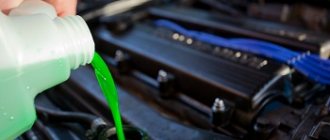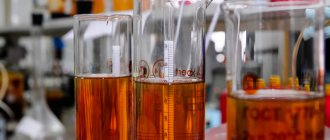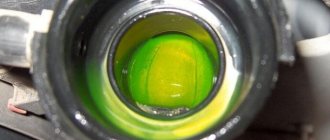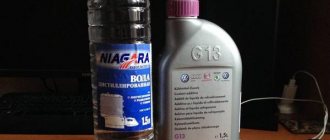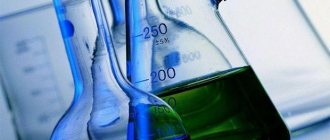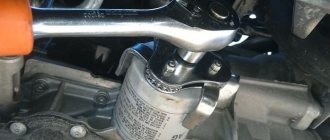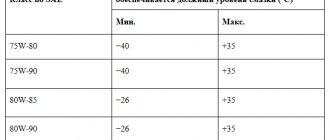What does the color of antifreeze mean?
Antifreeze of different colors on store shelves Answering the question posed in the title, we can confidently answer: absolutely nothing. It’s just that the manufacturer likes this or that shade, so he uses it to color products. However, there are many misconceptions surrounding this topic, which means that not everything is so simple. So, let's try to figure it out: antifreeze is red, green, blue - what's the difference?
What is antifreeze
What is antifreeze and what can be called this word? In English it translates as “non-freezing.” This is the common name for any coolant for a car’s cooling system. And this coolant is not water. Water freezes quickly, boils already at 100 degrees Celsius, and when freezing it expands, leading to ruptures and breakdowns of the system. That's why antifreeze was invented.
The composition of any of them includes an alcohol base, distilled water, and additives - organic or inorganic. It is also possible to add glycerin and other components.
Reviews of green antifreeze
When using green antifreeze, regardless of the manufacturer, drivers regularly note the following advantages:
⦁ excellent cooling and protection against overheating and hypothermia;
⦁ compatibility with all types of metals;
⦁ high level of protection against cavitation;
⦁ low temperature of the onset of crystallization;
⦁ versatility of application.
Based on this, the top three green antifreezes were compiled according to reviews from experts and car enthusiasts.
Sintec Euro G11
Sintec Euro G11
Even though this liquid is not included in the “long-lived” category, experts focus on its efficiency and reliability. The specificity of this antifreeze is the temperature at which crystallization begins, which exceeds the conditions by a margin: the coolant remains suitable in conditions down to -40 degrees Celsius. “I’ve been using this antifreeze for several years now, everything works fine, it doesn’t leak anywhere, it handles the winter as it should,” writes one of the ordinary users.
Service life - 3 years. The product demonstrates excellent anti-corrosion properties, being compatible with both aluminum and copper radiators.
LUKOIL Green G11
LUKOIL Green G11
Antifreeze is based on ethylene glycol using hybrid technologies. Used in closed cooling devices of automobiles. Productively protects against freezing and corrosion, prevents overheating of the cooling system and eliminates the occurrence of scale. The combination of inhibitors makes it possible to increase the mileage before the next replacement of the substance.
Thanks to the complex effect on the internal surface of the cooling system, it improves heat transfer and reduces the cost of repair maintenance.
Felix Prolonger G11
Felix Prolonger G11
Green hybrid coolant is used for cars, trucks and special vehicles, regardless of the complexity of operating conditions (climatic or road). This antifreeze is made from monoethylene glycol, demineralized water and high-quality additives. The manufacturer guarantees prompt engine warm-up, reduced fuel consumption and extended service life of the pump and radiator.
Among the advantages, it would not be out of place to note the increased mileage (up to 120 thousand km), good lubricating properties, thermal conductivity, maximum engine protection and compliance with international standards.
What color are antifreezes?
Antifreezes red, green, blue and yellow
All coolants also contain a dye. What color is antifreeze? The most commonly used are red, green, blue dyes and their shades - that is, blue, crimson, pink, light green, turquoise. There is also yellow, orange, violet, and with them lilac, lilac, yellow-green, red-orange.
Since there are no standards regulating the color of coolant, everything depends on the manufacturer’s imagination. What does the color of antifreeze mean, and what is coloring used for? Read on.
Why are they painted?
Why are antifreeze different colors? After all, the various colors of antifreeze are only misleading. It should be said that antifreeze itself is colorless and transparent. And there are three reasons for coloring it:
- Difference from water. Coolant is poisonous, so the main reason is so that it can be distinguished from water and not be drunk by mistake.
- Difference from each other. As a rule, the same brand has a whole line of liquids with different properties. If they were all the same color it would create confusion.
- Finding leaks. What color is antifreeze usually? Whatever it is, it is bright. This is done in order to quickly find leaks. For the same purpose, manufacturers often add a fluorescent dye to the composition, which can be detected under ultraviolet light.
Well, don’t forget about the marketing component. For example, there is a popular opinion that red is the best - so the manufacturer will use this shade.
Functions of specific colors
There are a large number of types of antifreeze on the modern automotive market. Available in many different colors, from blue to yellow. In addition, mixing of colors and the production of certain shades can occur.
It should be taken into account that the color of the coolant is done by the manufacturer - the color of the antifreeze does not indicate any technical properties. It is for this reason that the technical properties of such a liquid should be studied in advance. Manufacturers add color additives to coolants for the following reasons:
- Helps quickly and easily determine the location of the leak. To do this, use fluorescent lamps, which allow you to highlight areas of leakage.
- Helps prevent antifreeze from mixing with water. If coolant enters the body, it will cause multiple side effects, in some cases even death.
- Distinguishes certain types of antifreeze from others.
What is the difference between antifreeze colors?
As already mentioned, what colors antifreeze comes in is not regulated anywhere or by anyone. Where then do so many myths come from that claim, for example, what color antifreeze is best for which car? The thing is that although there are no requirements, most manufacturers adhere to unspoken standards. And here's what the shades mean:
Blue
Soviet TOSOL was painted blue or light blue, and it is still painted now. Is there blue antifreeze? First of all, it must be said that antifreeze is any coolant, which means antifreeze too. Other blue antifreeze is usually G11. These are traditional coolants. They are usually based on silicate additives. The peculiarity of such coolants is that they create a protective layer on the surface of parts, thereby preventing the formation of corrosion. But at the same time, heat transfer worsens.
Green
Green antifreeze brands are popular among motorists. Most often, liquids of standards G11 and G12+ are colored this way. The first ones are traditional. The second includes hybrid ones. They involve both organic and inorganic additives. This was done in order to combine the protective properties of silicates with the excellent thermal conductivity of carboxylic acids. Green coolant that meets these standards will last 2-3 years.
Red
The opinion that red antifreeze brands are the best is due to the fact that carboxylate coolants are often painted in it and its shades. They comply with the G12 or G12++ (improved) standard. These red antifreezes are based on organic additives that have excellent heat transfer and act specifically on corrosion - where it has already begun, but, alas, cannot prevent its occurrence. Red coolant is the most popular.
Yellow
But yellow antifreeze can meet any standard and be manufactured using any technology. Although most often hybrid and lobrid liquids are painted in it. There are also a variety of yellow-green coolants. As a rule, they are traditional or hybrid.
Violet
Violet dye, as well as lilac, lilac and pink, are most often used in the manufacture of G13 products. These are lobrid liquids. Their main difference is that propylene glycol is used as a base (all others use ethylene glycol). Therefore, they are considered more environmentally friendly and safer for humans. They also have a very long service life.
Is it possible to mix antifreeze of different colors?
Mixing red and blue antifreeze
The above division is very arbitrary and is not used by all manufacturers. There are coolant lines with the same composition, but painted in four to five different tones. This means that you cannot select and mix antifreeze by color.
This leads to the answer to the question: is it possible to mix antifreeze of different colors? It is possible only if they are based on the same technology and similar composition. You can mix red and green antifreeze if they are both carboxylate or both traditional!
Important! You should not listen to harmful advice that green can only be mixed with green, and red can only be added to red. Antifreeze color compatibility is nothing more than a myth. When choosing, the only thing you need to focus on is the production technology, which determines both the composition and properties.
And if you mix two products of the same tone, but of different composition, the liquid can thicken, precipitate and thereby harm the cooling system.
Blue liquid
Blue antifreeze brand Motul.
Antifreeze usually has this shade; it is mostly made in Russia. The composition includes first generation additives, nitrites, silicates, phosphates, borates. Due to these substances, a thin film is formed in the cooling system pipes that can protect metal and plastic from components that corrode it. However, antifreeze is quite aggressive, which is why many manufacturers do not recommend using it. This liquid boils at a temperature of +110 °C, so it is not suitable for high-speed cars whose engines operate at elevated temperatures.
What does it mean if the color changes
If during operation the color of the coolant changes slightly - it becomes darker or cloudy - this is normal. After all, in addition to the cooling function, it also has a cleansing function.
But if suddenly the antifreeze is brown and thick, and there is still a lot of time before replacement, this means that the cooling system is in poor condition. If the antifreeze has turned a rusty color, then most likely there are pockets of corrosion somewhere.
Thickening, cloudiness, and sedimentation can also occur if different compositions are mixed - even not on purpose. For example, a traditional one was poured, and you decided to switch to carboxylate. Drained the fluid and filled it with new one. But when the cream is creamed, some percentage of it remains inside the system. This is where the mixing occurs. Therefore, before replacing the coolant, the system must be flushed.
And, of course, the reason why antifreeze changes color may simply be its low quality.
How to profitably exchange a used car
To guarantee the legality of the used car exchange service and its objective cost, the purchase and sale process should be carried out at a trusted auto center. Here the client will be offered:
- Diagnostics of the old model, on the basis of which its cost will be determined;
- Selection of cars for exchange, completely new or with a clean mileage history: all cars undergo forensic examination, therefore the car dealership will never sell a car with a “dark past”;
- Legal support of the transaction: the client enters into a notarized agreement and, if necessary, can use the credit services of the car dealership’s partner bank;
- Efficiency of the service: the client does not need to look for buyers for his vehicle; he does not need to settle issues with the traffic police or the bank. The listed functions are the task of the auto center.
Read here! Which Lukoil oil is better to choose?
Thus, with minimal documents, it is possible to buy an improved car within one to three days. The used car exchange service makes it possible to regularly change the owner’s vehicle fleet by purchasing its best models.
conclusions
And now conclusions in the form of common questions and answers:
- Antifreeze red, green, blue - what is the difference between them? Most manufacturers color liquids of different standards in different colors.
- Can you mix different colors of antifreeze? It is possible if they are made using the same technology.
- Is it possible to mix red and green antifreeze? It is possible if they are both carboxylate or traditional.
- What does the color of antifreeze affect? The dye itself does not affect anything and does not change the properties of the liquid in any way.
- What colors of antifreeze can be mixed with each other? You need to mix liquids based on production technology, not color.
- The antifreeze has turned rusty, what is the reason? A change in color may indicate poor quality, mixing it with unsuitable coolant, or a problem with the cooling system.
Let's hope that this article will dispel motorists' doubts about colors and help them make the right choice!
Antifreeze red - green - blue. What is the difference? Just something complicated
Combining varieties
Many drivers believe that the color of antifreeze should not be mixed. However, if you decide to combine liquids of different shades, nothing bad will happen. You need to pay attention not so much to the color as to the composition of the acquired substance. It happens that products of different brands have different shades and contain slightly different additives, although it is stated, for example, that both products are G11. Manufacturers traditionally use dye for certain types of coolant, but this criterion is not regulated in any way, and the manufacturer may not comply with it.
